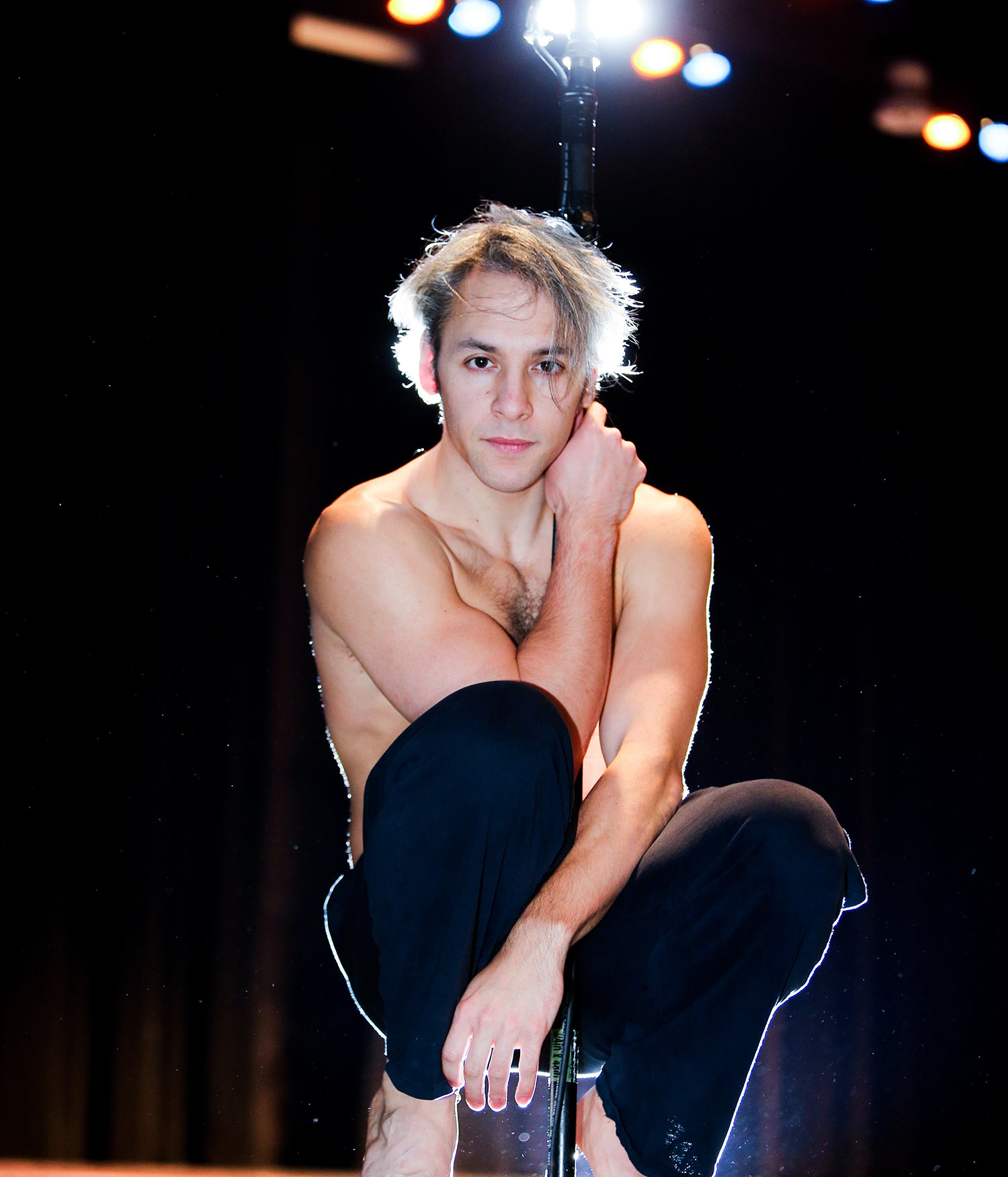Quincy Ellis sits cross-legged on the rehearsal hall floor of the Warner Theater in Torrington, his attention focused on the details of a dance piece performed by two members of the Pilobolus dance company. Ellis is learning the piece, which is part of the company’s large repertoire. He’s working especially on the more difficult cantilevered moves that strike just the right lyrical balance, and for which the company is famously known.
With long, silver hair, a compact frame and a personality that brightens a room, if not a stage, Ellis, like most performing artists around the globe, has been trying to keep a sense of balance in his own life for the past year as the Covid-19 pandemic halted live indoor performances and touring. But with vaccinations increasing and a confidence building for the fall, the dancers in this Connecticut-based company based in Litchfield County are gathering again, and the troupe is preparing for its 50th anniversary season.
While Ellis is hardly the first gay male dancer in the company, he is part of another new generation of artists that is making the company even more fluid, as it further explores gender, sexuality and the many meanings of movement.
COLLEGIATE ATMOSPHERE
The company was created 50 years ago by an unlikely gang of ivy league, heterosexual jocks who had taken a dance class at Dartmouth University as a gut course. But enchanted by instructor Alison Becker Chase—whose approach emphasized muscular movement over conventional dance technique for this raw group of dance virgins—the men were enthusiastic, creative and free-spirited.
With encouraging words from established modern dance directors Alwin Nikolais and Murray Louis, the guys were inspired to continue after college to create their own band of merry movers, which happened to coincide with an explosion of dance as an artform during the 1970s. The name Pilobolus was derived from a type of phototropic fungus, and the group chose the name because it sounded interesting. Their style has always been a mash up of gymnastics, physics, leverage, balance, and a bit of dance., all choreographed as a collaboration among the troupe’s members, rather than as the vision of one creator. As the company’s style emerged, they became known for its strength, playfulness and hot-blooded sensuality: Pilobolust.
Joining the company and softening and finessing the alpha vibe were Chase and Martha Clarke, who came to teach at Dartmouth in 1972. The company thrived and became a phenomenon, creating more than 120 pieces and performing in 65 countries around the globe.
Peter Pucci, a choreographer and dancer who performed with Pilobolus throughout the ‘80s, describes the image of the company in its first decades:
“The aesthetic in the beginning was like guys, straight guys. That’s what it was. We were all giddy and it was fun and zany and athletic and as far as the creativity — explosive. The reason I got into the company in 1980 had a lot to do with its athleticism but I’m sure it also had to do because I was straight, and it had that kind of collegiate atmosphere.”
In the late ‘80s, Jim Blanc became the first out male gay dancer in the company.
“Jim had an amazing physique,” says Pucci, recalling his friend who died of complications of AIDS in 1996 at the age of 36. “He was taller than the rest of us and he was so strong and gorgeous,” says Pucci, “there was never any resistance to anyone who was LGBTQ.” The company created a dance piece in Blanc’s memory following his death.
Many LGBTQ dancers followed over the decades including Vernon Scott, who was the first male gay black dancer in the company. The latest gay male to join the company is Ellis.
Today, artistic directors Matt Kent and Renee Jaworsk head the small company of diverse dancers and emphasize the collaborative development process that’s true to Piliobolus’ origins. They are reimagining some of the company’s classic pieces and creating new ones to reflect their identities and sensibilities.
“I want to see a perspective that is different than mine,” says Kent.
GROWING UP
Like the Pilobolus founders, Ellis did not expect to become a professional dancer.
Growing up in lower central Maine, his interests during elementary and middle schools were first in competitive gymnastics and then in figure skating. But in high school, he turned to the arts. He describes himself then as “a theater nerd.”
As far as his sexuality, Ellis, now 35, didn’t come out until he was 21. “I realized I was gay in middle school, but I didn’t deal with it then or in high school. It wasn’t until junior year in college when I started dating that I came out to everyone.”
After graduating from Emerson College in Boston where he studied acting, he moved to New York City in 2008, with his boyfriend at the time.
Disliking the audition process for actors, Ellis found himself connecting more with college pal Leslie Guyton, a dancer who was creating movement pieces with her MoveShop company. It was an arts community in New York in which resonated with him, and he became more and more involved with them.
“I found myself in my mid-20s taking dance classes just to keep up with what she was interested in,” he says.
In 2014 Ellis saw a posting for male dancer auditions for Pilobolus and a friend urged him to try out. “She said this company is right up my alley,” says Ellis who had only a vague notion of what the company was.
After making it past the first cut in the audition, “the rest of the day it was just improvisation and fun. It reminded me of movement classes for actors in college, and improvising was something I was not scared of at all. I had a blast.”
He didn’t make the final cut, but the company kept him on its radar.
Two years later, Ellis saw Pilobolus perform live for the first time and thought, “Oh, crap. I really want to do that.”
“That period was a weird time of my life. I turned 30. I was also going through a divorce. Everything seemed to be shifting in my life at once.”
He auditioned again for Pilobolus in early 2017, and this time he got the gig. It changed everything for him.
“In many ways, Pilobolus saved my performance life. It really did. I was looking at other career paths, and I was on the verge of saying, ‘I’m done.’ Then something that I never thought was going to happen, happened. And it was like, OMG.”
JOINING THE COMPANY
When Ellis first joined Pilobolus he was coming off having been involved for a few years in the drag community — not as a drag performer but as a dancer with his friend [and “RuPaul’s Drag Race contender] Miz Cracker as well as Juicy Liu in the drag nightclub scene.
After living in the professional drag world for so long, going into Pilobolus “felt like entering a more traditional ‘masculine’ realm,” but one “that is definitely part of who I am as a person, too. I often giggle to myself because I remember there was this sort of ‘boys’ club’ in college for the ‘super-hetero’ people that we used to joke about. When I got into Pilobolus I felt like I snuck into that boys’ club.”
Though Pilobolus had many LGBTQ dancers over the decades — and the ensemble just before Ellis joined had three gay men, he says — there were no gay men in the company upon Ellis’ arrival. “I was the only one. I thought, ‘Oh, this is the other side of the coin.’
“But I didn’t feel the need to put on a mask to be accepted. It just felt like I was exploring that masculine side of myself that I hadn’t been exploring because I was working with the world of drag, exploring who I was in a different realm. A lot of early Pilobolus pieces that I was learning had to do with that part of masculinity.
“I think the Pilobolus pieces that have been created on LGBTQ performers definitely have a sense of subtlety and—dare I say the word?—femininity, which made it really beautiful to watch.”
Could drag elements from Ellis’ background be integreated into future pieces? Or would that be too far away from that early Pilobolus brand?
“Elements of drag could be used—and have been used in the past. But there are parts of the new drag culture that haven’t been used before, and I could see maybe that coming into the company in the future.
“We’re always open to explore what interests us at the time. I know I have no reservations in expressing my perspective as a gay man about what is being created, and I know the artistic directors take that into account. It may not be like shooting a rainbow across the stage but those hints of myself are there and being respected in what is being created.
“But I am also an actor, so telling that story from a more heterosexual perspective isn’t something that is inhibiting to me. I get to play a role, and that interests me, too, because it’s not life. But because I am a gay man coming to that role, I also know that little bits of who I am are going to come out in that regardless.”
COMING SEASON
As for his personal life, Ellis’ partner is Australian who is currently living there. “We haven’t seen each other in over a year because of Covid-19 so that’s been incredibly challenging [because of visitor restrictions].
“I’m not sure where is home for me now,” he says. During the pandemic Ellis left his New York apartment when his lease was up and returned to his family home in Maine until this past spring. “I guess right at this moment home is a house the dancers share in Bantam as we work on dances,” he says referring to Marlon Feliz, Casey Howes and Paul Liu.
Because of the pandemic and the fluctuating restrictions, the coming anniversary season is as constantly shape shifting as one of Pilobolus’ pieces.
There was a second summer outdoor immersive “car safari,” titled “Bloom: A Journey,” which will be held July 21 to 25 at Sunny Meadow Farm in Bridgewater. It was quickly sold out, just as it as the previous year.
A new four-person show “Four@Play” has also been created and designed for performance spaces across the country as they emerge from audience restrictions, especially outdoor venues. The 50th anniversary 2021-’22 tour is currently in flux but it will include returning to New Hampshire’s Dartmouth University.
Pilobolus at 50—and with new artistic directors—is finding “the boundaries are being pushed but those things always feel like they take time especially with the older repertory,” says Ellis. “It’s interesting to be a member of the company as this shift has been happening. The passing of the torch to new artistic direction.”
How the future of Pilobolus shapes up will be as interesting offstage as it has always been onstage.
For more information about the company and its performance events, go to Pilobolus.org.
By FRANK RIZZO / Photography by STAN GODLEWSKI










More Stories
Broadway Review: Art
Fall Arts Preview: Emus, Foxes and Eric Clapton, Too
Diane DiMassa Book Event September 25